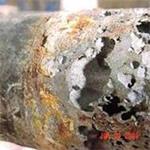We usually think that the so-called “stainless steel” that I bought is indeed stainless steel. The truth is that most of these “stainless steel” materials not only lose metallic luster, but can also be severely corroded when in contact with common salts.
Why does stainless steel rust?

In theory, stainless steel has the ability to resist atmospheric oxidation – that is, rust, and also has the ability to resist corrosion in medium containing acid, alkali, and salt – that is, corrosion resistance. However, the degree of corrosion resistance varies with the chemical composition of the steel itself, the state of addition, the conditions of use, and the type of environmental medium.
It is a very thin and strong and stable chromium-rich oxide film (passivation film) formed on the surface to prevent the oxygen atoms from continuing to infiltrate and continue to oxidize, thereby obtaining the ability to resist rust. Once for some reason, the film is constantly destroyed, oxygen atoms in the air or liquid will continue to infiltrate or iron atoms in the metal will be continuously separated, forming loose iron oxide, and the metal surface will be continuously rusted.
How do food factories choose stainless steel of different materials?
When it comes to the difference between stainless steel materials, we must first understand the characteristics of each common stainless steel material. We often mention these stainless steel figures, 201/304/316.
201 stainless steel
201 stainless steel is the most cost-effective stainless steel material, cheap, but easy to rust
304 stainless steel
The most common and widely used stainless steel material, it is not easy to rust, the quality is good, and the price is relatively high.
316 stainless steel
It is an imported material used in some high-end equipment, such as aerospace, food machinery and other fields, and the price is high.
Let’s take a closer look at the differences between these common stainless steel materials.
What is the difference between stainless steel 304 and 201?
In the eyes of many consumers, there is almost no difference between 304 stainless steel and 201 stainless steel, which can hardly be distinguished by the naked eye.
the difference
⊙201 is high in manganese, the surface is very bright and dark, and the manganese is high and easy to rust.
⊙304 contains more chromium, the surface is matte, does not rust. The two are put together to compare.
The most important thing is that the corrosion resistance is different. The corrosion resistance of 201 is very poor, so the price is much cheaper.
And because 201 contains low nickel, the price is lower than 304, so the corrosion resistance is not as good as 304.
Difference between 304 and 316 stainless steel
Its practical naked eye can’t see the difference between 304 and 316 stainless steel. Many people see these numbers on the fog.
the difference
⊙ 316 stainless steel contains Mo, which is better than 304 stainless steel in high temperature environment. Therefore, in high temperature environment, equipment of 316 material is generally used.
⊙316 mainly reduces the Cr content and increases the Ni content and increases Mo2%~3%. Therefore, its corrosion resistance is stronger than 304, and it is suitable for use in chemical, seawater and other environments.
Of course, the expensive 316 is also very characteristic.
For example, 304 steel pipe has absolutely excellent rust resistance in a dry and clean atmosphere, but it is moved to the coastal area, and it will soon rust in sea fog containing a lot of salt; while 316 steel pipe will perform. good.
How do food factories choose stainless steel of different materials?
It is not any kind of stainless steel, it can resist corrosion and rust in any environment.